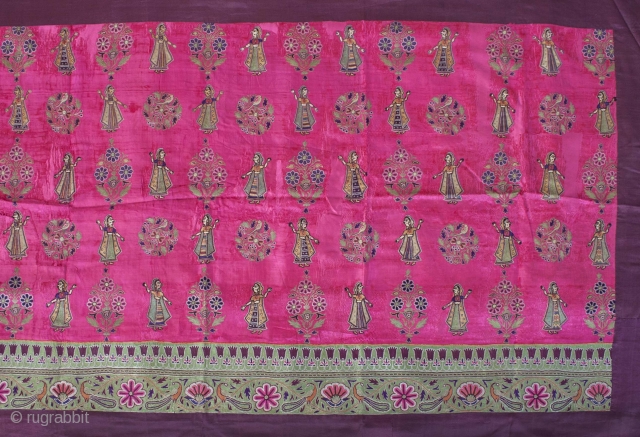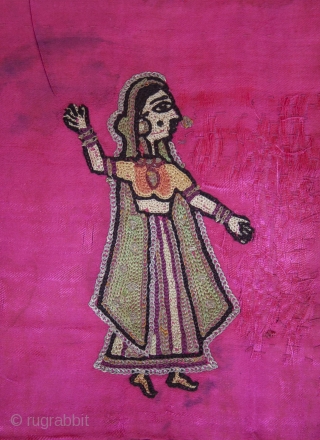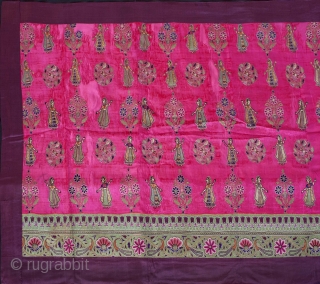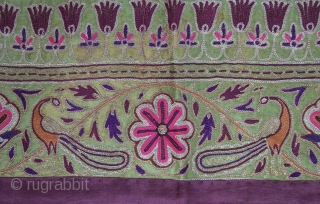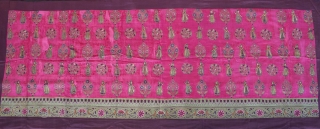Back
This particular embroidered piece is a figment of imagination translated by the Mochis of Kutch and Saurashtra, Gujarat, India to the regal embodiment of the late 19th century. Traditionally, as cobblers and leather workers, the Mochis developed the art of embroidering fine silk threads on silk cloth in chain stitches using an ari, a fine awl like hooked needle that resembles a European tambour hook. The technique that crossed borders, from Sind to Bhuj also evolved in materials; from leather to cloth.
The Mochis flourished due to the patronage of Kathi landowners. But by 1947, their declining wealth and imminent migration led the Mochis to virtually disappear.
Typical to the style of Mochi Embroidery, depicted here, are maidens dressed in the traditional costumes, all of different patterns, dancing to the rythms of an unknown folk song. They dance in the pink meadow spotted with floral motifs or Butas, circular and oval in shape. Perched among them is the famous Indian parrot. On the borders are stylised adaptations of the peacock amidst the rich flora and foliage.
These motifs and patterns are derived from Persian and Mughal sources with confluences of Western Indian artistic sensibilities. This piece is a specimen of outstanding craftsmanship that exudes beauty of the beholder and artistic flair of the creator.
The design sensibility seen here in the birds and human figures, created with the detailed delicacy are one of the very few specimens of the age gone by, which could not possibly be brought back.
It dates late 19th or early 20th c.
SIZE: 34 x 86 inches
price:
Price on request
- Home
- Antique Rugs by Region
- Category
- Profiles
- Post Items Free
- Albums
- Benaki Museum of Islamic Art
- Budapest: Ottoman Carpets
- Gulbenkian Museum
- Islamic Carpets. Brooklyn
- Islamic Textiles. Brooklyn
- Konya Museum: Rugs
- MKG, Hamburg
- MMA: Caucasian Carpets
- MMA: Mamluk Carpets
- MMA: Mughal Indian Carpets
- MMA: Ottoman Carpets
- MMA: Safavid Persian Carpets
- MMA: Turkmen Rugs
- McCoy Jones Kilims
- Ottoman textiles. Met
- Philadelphia Museum
- Rugs and Carpets: Berlin
- Seljuqs at the Met
- TIEM, Istanbul: Carpets
- V&A: Classical Carpets
- Vakiflar Carpets: Istanbul
- Baluch Rugs: Indianapolis
- Gallery Exhibitions
- Jaf an Exhibition
- Alberto Levi Gallery
- Andean Textile
- Christie's London: 2016
- Francesca Galloway
- HALI at 40
- ICOC Washington, DC 2018
- Jajims of the Shahsavan
- London Islamic Week April, 2018
- Mongolian Felts
- Navajo Rugs: JB Moore
- Persian Piled Weavings
- SF Tribal & Textile Art Show 2020
- SF Tribal 2019
- Sotheby's: C. Alexander
- Turkish Prayer Rugs
- Turkmen Main Carpets ICOC 2007









